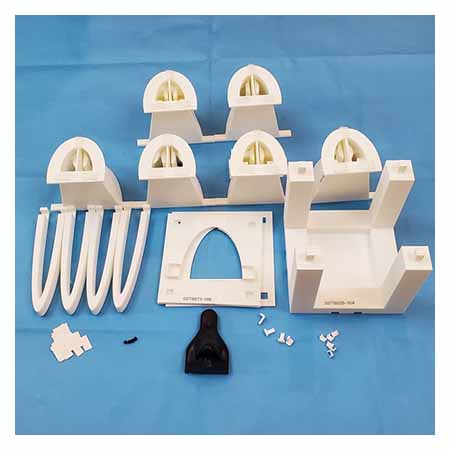3D Printed Models for Sinus Surgery Simulation Improve Resident Learning
 The maze-like structure of the paranasal sinuses presents significant challenges to surgical trainees in otorhinolaryngology as they perfect their endoscopic sinus surgery skills. In a study conducted among 10 residents in the Department of Otorhinolaryngology-Head and Neck Surgery at McGovern Medical School at UTHealth Houston, the researchers found that their set of novel three-dimensional (3D) printed models of the nasal cavity can serve as a low-cost, reusable tool adjunct to traditional resident education and help improve surgical quality.
The maze-like structure of the paranasal sinuses presents significant challenges to surgical trainees in otorhinolaryngology as they perfect their endoscopic sinus surgery skills. In a study conducted among 10 residents in the Department of Otorhinolaryngology-Head and Neck Surgery at McGovern Medical School at UTHealth Houston, the researchers found that their set of novel three-dimensional (3D) printed models of the nasal cavity can serve as a low-cost, reusable tool adjunct to traditional resident education and help improve surgical quality.
“The challenges of training new endoscopic sinus surgeons are compounded by a visual disconnect as surgeons move their hands in a 3D space while viewing their moves on a two-dimensional screen,” says William C. Yao, MD, associate professor and director of the residency program in the Department of Otorhinolaryngology at the medical school. “Formerly, our residents practiced endoscopic techniques in cadavers and in the operating room, which are limited by cost and patient safety, respectively. Given these constraints, we’ve found surgical simulation to be an attractive method of training for endoscopic sinus surgery.”
After creating a 3D model, Dr. Ahmad and Dr. Yao worked with other residents to ask them to complete a self-assessment survey of 10 questions on their perceived sinus surgical skills, and then rotated through four stations, each with different training modules developed by the article authors.1 All residents rated their overall sinus surgery skills higher post-intervention than pre-intervention. All junior trainees reported improved spatial awareness working with endoscopes and surgical instruments.
“Junior residents were far more likely to perceive improvement in their endoscopic skills with use of the 3D simulator compared to our senior residents due to the difference in experience level,” Dr. Yao says. “Through previous training, the seniors had acquired the skill set needed to move the endoscope back and forth in various planes. The 3D printed models especially help junior residents learn the fundamentals because they allow for increased opportunity for repetition of touches and moves in the endoscopic view.”
Juman Ahmad, MD, a fourth-year otorhinolaryngology resident, presented the study results during the Simulation Tank presentation at the American Academy of Otolaryngology-Head and Neck Surgery meeting held in September in Philadelphia.
Reference
Ahmad J, Citardi AJ, Luong AU, Yao WC. Three-Dimensional Printed Models to Accelerate Resident Surgical Learning Curve for Standard Endoscopic Sinus Surgery Techniques. Ear Nose Throat J. 2022 Aug 11;1455613221120049. Online ahead of print.